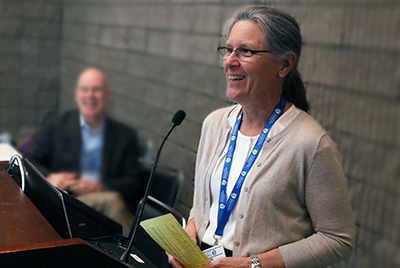Curbside Consultation in Collaborative Care Is All About Education

You’re the consulting psychiatrist in a collaborative care network when you receive the following telephone call from the network’s behavioral health professional: “The primary care provider wanted me to call you. We have this girl who has done well on Strattera 40 mg per day, but now her insurance company won’t pay for it so we need to try something else. She had trouble in the past with Adderall and methylphenidate. What should we do, try Adderall again?”
As the consulting psychiatrist, what other information do you want to know? Are there any measurement tools you would suggest? What recommendations would you offer, and what kind of education would you offer to the behavioral health provider?
That’s one exercise in “curbside consultation” that psychiatrists attending the lecture “Effective Curbside Consultation” practiced yesterday at APA’s Annual Meeting. Lori Raney, M.D. (pictured above), chair of the APA Work Group on Integrated Care, and John Kern, M.D., director of the Regional Community Mental Health Center in Merrillville, Ind., described the essentials of curbside consultation, modeled several consultations, and then asked attending psychiatrists to practice with each other using hypothetical scenarios like the one described above.
Every consultation with primary care is an opportunity for education, they emphasized.
Curbside consultation with primary care—either directly or through a behavioral health professional who works within the primary care clinic—is an essential skill for psychiatrists participating in collaborative care networks. Psychiatrists need to be readily available to consult—within two hours of the initial request—and should be welcoming to primary care physicians who may be anxious and worried about a case. “‘I’m here to help you. How can I help you?’ should be your mantra,” Raney said.
“Curbside consultation boils down to how much information we can translate to the primary care physician in three to six minutes,” Raney said. “But it’s more than merely giving someone information. It’s about educating primary care doctors about behavioral and mental health.”
Raney and Kern said the top reasons that primary care physicians call psychiatrists for consults are medication choice, diagnosis clarification, information about behavioral interventions, and general education. The top disorders that primary care physicians call about are anxiety disorders, major depression, substance use, and “difficult” patients.
Raney and Kern also emphasized that psychiatrists should be ready and willing to consult about all manner of behavioral issues, regardless of specialty training. “Just because you are a general psychiatrist, you can’t say, ‘I don’t do child psychiatry,’” Kern said.
(Image: David Hathcox)
|
|
|
|
|


